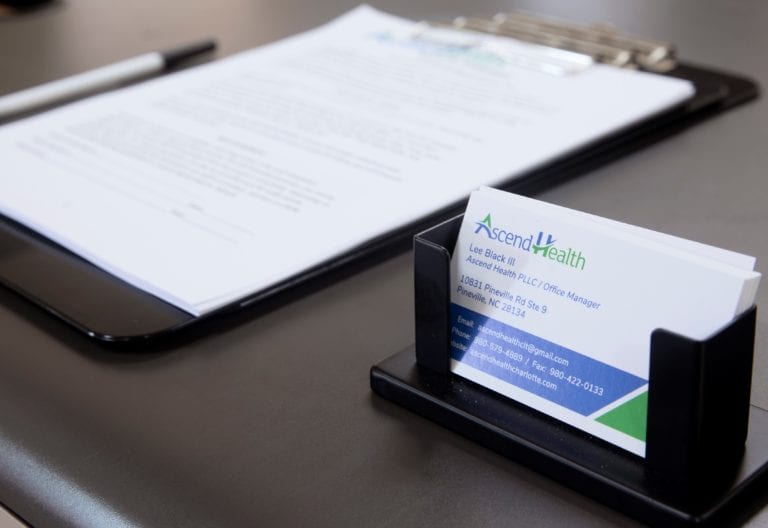Finding the right buprenorphine addiction treatment program is critical to your recovery journey. Opioid use disorder affects more than 2.4 million adults in the United States and over 26 million people worldwide. If you or a loved one struggles with dependence on prescription opioids, heroin, or other opioid substances, you need a treatment model that combines medical care, counseling, and long-term support.
Ascend Health’s outpatient buprenorphine model offers a comprehensive approach designed for adults like you who seek recovery with the convenience of office visits or telehealth sessions. Our licensed clinicians leverage the latest research and clinical guidelines to tailor individualized plans that incorporate medication, therapy, and peer support. With same-day access, insurance verification support, and strict confidentiality, you can take the first step toward lasting sobriety with confidence.
Understand buprenorphine therapy
Medication-assisted treatment remains underutilized despite its proven benefits. SAMHSA funds the Providers Clinical Support System – Medications for Opioid Use Disorders (PCSS-MOUD) to train and mentor clinicians in identifying and treating OUD, expanding access to life-saving care [1]. This initiative ensures that you receive care from providers who stay current with best practices.
What is buprenorphine?
Buprenorphine is a partial mu-opioid receptor agonist approved for treating opioid use disorder. Unlike full opioid agonists such as methadone or heroin, buprenorphine produces milder opioid effects, making it safer and less likely to be misused. Its pharmacological profile supports long-term maintenance while minimizing common risks associated with opioid therapy.
How buprenorphine works
Buprenorphine binds tightly to opioid receptors in the brain, reducing withdrawal discomfort and diminishing cravings without the intense euphoria linked to stronger opioids. Its ceiling effect on respiratory depression lowers overdose risk, providing both safety and efficacy when taken as prescribed. This balance helps you regain stability and focus on recovery.
Benefits of buprenorphine
- Reduces opioid withdrawal severity and cravings
- Lowers overdose risk through its ceiling effect on respiratory depression
- Can be prescribed in physician offices or dispensed at certified opioid treatment programs
- Recommended for pregnant or breastfeeding women as a first-line therapy
By targeting the underlying neurobiology of addiction, buprenorphine offers a medically sound path to recovery that complements counseling and holistic care.
Research and outcomes
A Cochrane Review of 27 randomized controlled trials with over 3,000 participants found that buprenorphine:
- Was similarly effective to methadone for managing opioid withdrawal symptoms
- Provided significantly fewer withdrawal symptoms and longer treatment retention compared to clonidine and lofexidine
- Had no increase in adverse events versus non-opioid withdrawal agents
- Demonstrated a higher likelihood of treatment completion compared to clonidine or lofexidine
(NCBI Bookshelf)
These findings support buprenorphine as a safe, effective core component of an outpatient MAT program.
Explore program options
Whether you prefer in-person visits or remote care, you can find a program structure that fits your lifestyle and needs.
Office-based buprenorphine prescribing
Buprenorphine is the first OUD medication approved for prescription in physician offices. This model increases access to treatment, allowing you to see a licensed clinician in a familiar setting and integrate medication management with ongoing counseling. Office-based care often includes regular check-ins, routine lab work, and direct communication with your prescriber.
SAMHSA-certified opioid programs
In addition to office-based care, buprenorphine is available at SAMHSA-certified opioid treatment programs (OTPs). These outpatient facilities provide a structured environment with daily or weekly visits, medical supervision, and peer group therapy sessions. This cohesive setting fosters accountability and mutual support.
Outpatient Suboxone clinics
Suboxone combines buprenorphine with naloxone to deter misuse. You can enroll in an outpatient suboxone treatment program for flexible scheduling, private care rooms, and coordinated therapy sessions. Many patients find this option effectively balances convenience with comprehensive support.
Extended-release injection option
If daily dosing does not fit your routine, Ascend Health offers a sublocade injection treatment program that delivers monthly sustained-release medication. This approach reduces pill burden, enhances adherence, and can simplify your treatment schedule.
Hybrid care models
Some patients benefit from a blend of office visits and telehealth check-ins, combining face-to-face assessments with virtual support. Ascend Health’s hybrid model allows you to adjust the mix of in-person and remote appointments based on your progress and preferences.
Navigate coverage and costs
Understanding your insurance benefits can help you access care with minimal financial stress.
Insurance verification support
At Ascend Health, our team assists you in verifying coverage through an insurance verified MAT program. We work directly with your provider to confirm benefits, explain any prior authorizations required, and outline potential out-of-pocket costs before you begin.
Accepted insurance plans
We accept major carriers, including Blue Cross Blue Shield, Aetna, Medicare, and Medicaid. If you have another plan, reach out and we can determine your options. Medication copays may range from $10 to $50, and visit copays depend on individual plan features.
Medication cost assistance
Many patients benefit from manufacturer assistance programs, generic buprenorphine options, and copay cards that reduce monthly medication expenses. Ascend Health can connect you with resources that may lower or waive your out-of-pocket costs, even if you have a high deductible.
Private pay options
If you lack insurance or prefer not to use benefits, ask about our private pay options. We strive to make care affordable and accessible, with transparent fee schedules and potential sliding-scale discounts.
Begin your treatment
Starting your MAT journey involves a structured process to ensure safety and comfort.
Initial assessment process
Your first appointment includes a thorough evaluation of your medical history, substance use pattern, and recovery goals. A licensed clinician will review your current medications, conduct a physical exam, and screen for mental health conditions. You may also complete questionnaires like the PHQ-9 for depression or the GAD-7 for anxiety to inform your treatment plan.
Laboratory monitoring
Routine lab tests—including liver function panels, kidney function tests, and occasional blood counts—help clinicians detect metabolic changes or early signs of adverse effects. Urine drug screens verify adherence and detect concurrent substance use, guiding adjustments to your treatment plan.
Induction phase overview
To begin buprenorphine, you must be in mild-to-moderate withdrawal, typically 12 to 24 hours after your last opioid use [1]. Starting too early can trigger precipitated withdrawal. During induction:
- You receive a test dose (usually 2 mg to 4 mg sublingually).
- Clinicians monitor your response, adjusting the dose every few hours as needed.
- Clear communication about symptoms helps optimize comfort and safety.
Stabilization and maintenance
As withdrawal symptoms ease, your dose is fine-tuned to control cravings without sedation. Stabilization typically occurs within the first four weeks. After that, you transition to buprenorphine maintenance therapy, which may include alternate-day dosing or a consistent daily dose, depending on your needs. High-dose regimens (16 mg or more per day) have been shown to improve treatment retention and reduce opioid use [2].
| Phase | Timeframe | Key actions |
|---|---|---|
| Induction | Day 1 to Day 3 | Achieve mild withdrawal, start medication dose |
| Stabilization | Week 1 to Week 4 | Adjust dosage, monitor response and tolerance |
| Maintenance | Month 1 onward | Transition to stable dosing, continue counseling |
Your clinician will recommend a schedule of follow-up visits—often weekly during stabilization and biweekly or monthly once you are stable—to monitor progress and address challenges.
Combine therapy support
Medication is most effective when paired with counseling and peer support.
Counseling and behavioral therapy
Integrating cognitive behavioral therapy, motivational interviewing, and contingency management helps you identify triggers, develop coping skills, and strengthen relapse prevention strategies. Research shows that combining Suboxone with therapy improves treatment retention and overall effectiveness [3].
Contingency management
This evidence-based approach uses positive reinforcement—like vouchers or small rewards—to encourage treatment adherence and abstinence. Studies have shown contingency management can improve engagement and reduce relapse when paired with MAT programs.
Peer support groups
Joining communities like SMART Recovery or Narcotics Anonymous builds a network of peers who understand your journey. These groups reinforce accountability, offer encouragement between clinical visits, and provide practical strategies for everyday challenges.
Treat co-occurring conditions
Addressing depression, anxiety, or PTSD alongside OUD leads to greater treatment success. Many outpatient programs offer integrated psychiatric care, medication management, and holistic approaches—such as yoga, meditation, and art therapy—to support whole-person recovery [3].
Family involvement
Research indicates that family support enhances outcomes by improving motivation and reducing isolation. Our programs invite loved ones to participate in select sessions, fostering understanding and aiding your long-term recovery.
Monitor safety and side effects
Tracking your response and any adverse reactions is vital for a smooth recovery.
Common side effects
- Constipation
- Headache
- Nausea
- Sweating
- Insomnia
These effects often diminish over time. Report persistent symptoms to your clinician, who may adjust your dose or recommend supportive treatments.
Serious side effects
- Respiratory depression
- Severe allergic reactions
- Heart rhythm changes
- Adrenal insufficiency
Contact your healthcare provider immediately if you experience any serious events [1].
Drug interactions
Buprenorphine can interact with benzodiazepines, certain antidepressants, and some HIV medications. Your clinician will review your full medication list and adjust doses or recommend alternatives to prevent adverse interactions and ensure safe treatment.
Managing precipitated withdrawal
Though precipitated withdrawal occurs in about 9 percent of inductions, proper timing and dosing reduce this risk [4]. Risk factors include recent benzodiazepine use, switching from long-acting opioids, or a low initial buprenorphine dose. If symptoms arise, clinicians may:
- Provide reassurance and symptom-targeted medications
- Increase buprenorphine dosing incrementally
- Consider alternative OUD treatments if needed
Additionally, periodic urine drug screens and laboratory tests help ensure medication adherence and detect any interactions early.
Manage recovery expectations
Recovery is a personal journey with milestones that vary from person to person.
Recovery timelines
While some individuals achieve stability within months, others may require a year or more of maintenance therapy. Your progress depends on factors such as duration of opioid use, co-occurring mental health conditions, and support network. Setting realistic timelines helps you stay motivated.
Measuring success
Clinicians track outcomes via:
- Self-reported craving and withdrawal scales
- Urine drug screens
- Quality of life assessments
- Employment or education milestones
Setting measurable goals—such as reducing opioid use, rebuilding relationships, or returning to work—provides tangible benchmarks for your progress.
Preventing relapse
Ongoing support is key to relapse prevention. Strategies include:
- Continued counseling
- Regular peer support attendance
- Consistent medication adherence
By recognizing early warning signs and accessing prompt clinical support, you can maintain your recovery trajectory.
Choose your provider
Selecting a supportive, knowledgeable team sets the foundation for lasting recovery.
Same-day and telehealth access
Ascend Health offers same day suboxone appointment and telehealth suboxone clinic appointments for when you need an immediate start or ongoing check-ins from home. Telehealth provides flexibility, reduced travel time, and access to care regardless of your location.
Licensed clinician oversight
Our team includes physicians, nurse practitioners, and licensed counselors trained in MAT. All sessions are strictly confidential under HIPAA standards, ensuring your privacy confidential outpatient mat services.
Evidence-based approach
We adhere to national guidelines and best practices, combining medication, therapy, and support strategies shown to enhance retention and recovery outcomes. Our clinicians regularly participate in ongoing training through PCSS-MOUD to stay at the forefront of opioid treatment innovations.
In-network treatment
Ascend Health is an in-network suboxone treatment provider for most major insurance plans. Staying in-network can reduce your out-of-pocket costs and simplify claims processing.
Schedule your appointment
Getting started is simple and secure.
Prepare for your visit
Gather your photo ID, insurance card, and a list of current medications. Completing this paperwork ahead of time streamlines your initial assessment.
Confirm your coverage
Use our online verification tool or call our team to check benefits for an insurance covered outpatient mat. We will outline any copays or deductible requirements so you can plan accordingly.
Get started today
You can schedule a telehealth mat appointment scheduling online or call our office. Our friendly staff will guide you through the next steps, answer questions, and help you access immediate support.
Feel confident knowing you have a comprehensive, confidential, and evidence-based program at your side. Share your concerns, build your support network, and reclaim control over your health with Ascend Health’s expert team.



